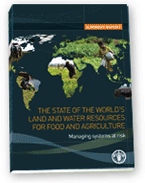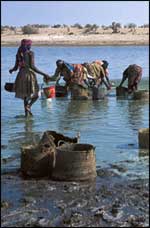The State of the World's Land and Water Resources for Food and Agriculture (SOLAW) | managing systems at risk
THE REPORT
 A major objective of the State of the World's Land and Water Resources for Food and Agriculture (SOLAW) is primarily to raise awareness on the status of land and water resources, at the same time it scopes and inform on opportunities and challenges. Throughout the years, FAO has established itself as a unique source for a variety of global data on land and water. This book takes full advantage of these data, presenting the most comprehensive and up-to-date global overview of the availability of land and water resources, their use and management, as well as related future trends and developments. SOLAW takes into consideration major drivers of global change, including demands driven by demographics, changing consumption patterns, biofuel production and climate change impacts.
A major objective of the State of the World's Land and Water Resources for Food and Agriculture (SOLAW) is primarily to raise awareness on the status of land and water resources, at the same time it scopes and inform on opportunities and challenges. Throughout the years, FAO has established itself as a unique source for a variety of global data on land and water. This book takes full advantage of these data, presenting the most comprehensive and up-to-date global overview of the availability of land and water resources, their use and management, as well as related future trends and developments. SOLAW takes into consideration major drivers of global change, including demands driven by demographics, changing consumption patterns, biofuel production and climate change impacts.
The SOLAW report, deals primarily with the issue of land and water for crops. It examines the kinds of production responses are necessary to meet demand, while assessing the potential of the world’s land and water resources to support these desired increases in output and productivity. Risks and tradeoffs are examined, and options reviewed for managing these without harm to the resource base.
 The five main chapters cover an analysis of the current status of land and water resources together with trends. They offer an assessment of the biophysical and technical aspects of the resources and their use, including projections for the year 2050. They review current institutional arrangements, and assess socio-economic and environmental impacts of current land and water management. Current and future threats to land and water are also reviewed, together with their implications for a series of major systems at risk. A series of requirements and options to achieve the necessary levels of output and productivity required in a sustainable way are presented. Finally, the report assesses the institutional responses at local, national and international levels, with an analysis of lessons for the future. The conclusions present some policy recommendations. What is offered is a pragmatic step by step approaches towards a more sustainable, lower-carbon intensive agricultural production that is based on ecologically-sensitive management of land and water by farmers, supported by policies, and institutions.
The five main chapters cover an analysis of the current status of land and water resources together with trends. They offer an assessment of the biophysical and technical aspects of the resources and their use, including projections for the year 2050. They review current institutional arrangements, and assess socio-economic and environmental impacts of current land and water management. Current and future threats to land and water are also reviewed, together with their implications for a series of major systems at risk. A series of requirements and options to achieve the necessary levels of output and productivity required in a sustainable way are presented. Finally, the report assesses the institutional responses at local, national and international levels, with an analysis of lessons for the future. The conclusions present some policy recommendations. What is offered is a pragmatic step by step approaches towards a more sustainable, lower-carbon intensive agricultural production that is based on ecologically-sensitive management of land and water by farmers, supported by policies, and institutions.
The SOLAW Report will be available in the last quarter of 2011
WHY THE REPORT
Land and water resources are central to agriculture and rural development and are intrinsically linked to global challenges of food insecurity and poverty, climate change adaptation and mitigation, as well as degradation and depletion of natural resources that affect the livelihoods of millions of rural people across the world.
Current projections indicate that world population will increase from 6.9 billion people today to 9.1 billion in 2050. In addition, economic progress, notably in the emerging countries, translates into increased demand for food and diversified diets. World food demand will surge as a result, and it is projected that food production will increase by 70% in the world and by 100 % in the developing countries. Yet, both land and water resources, the basis of our food production, are finite and already under heavy stress, and future agricultural production will need to be more productive and more sustainable at the same time.
Visit the SOLAW Website >>
